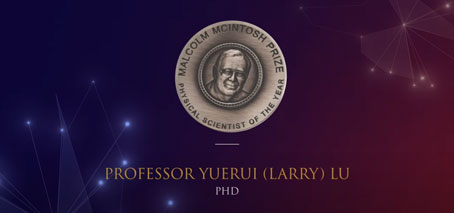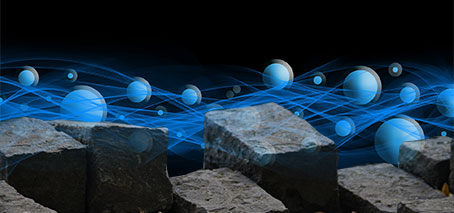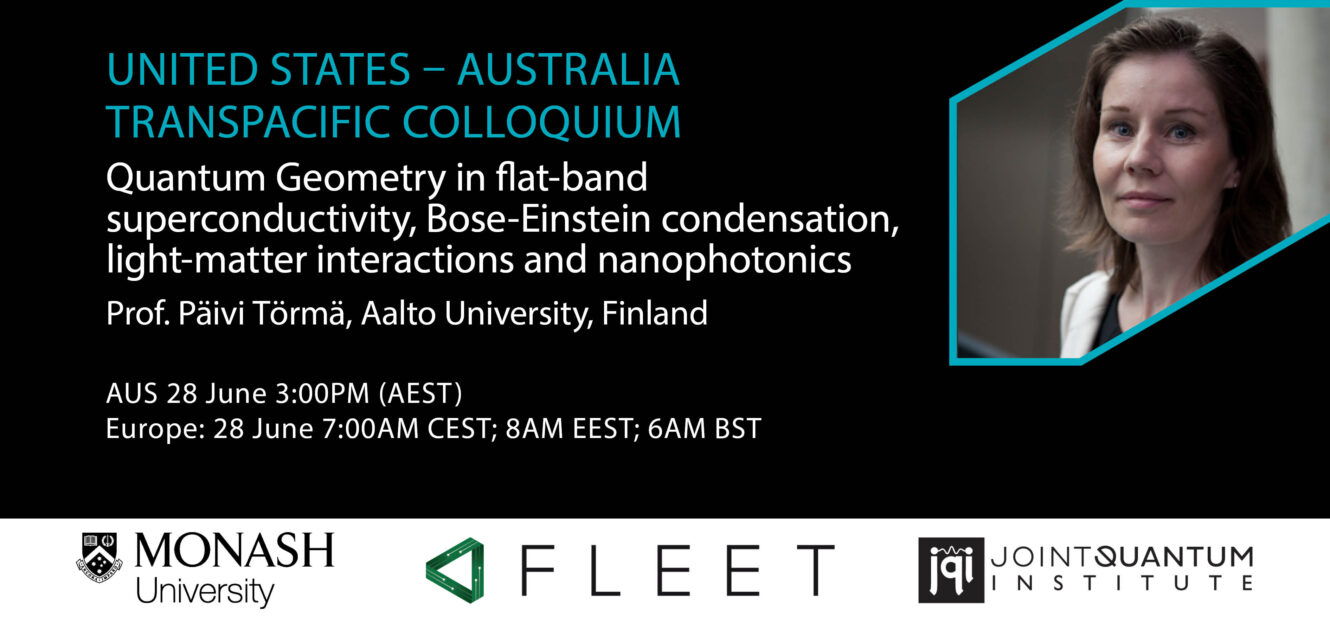Kyle Boschen completed his Honours project in 2022 and is now undertaking a PhD in CI Jeff Davis‘ group. He is investigating the properties of two dimensional semiconducting TMDs using ultrafast spectroscopy. The project fits the FLEET Enabling Research Theme 2, Exciton Superfluids
Probing proximity in topological insulator / magnetic insulator heterostructures
Magnetic proximity between topological insulators and magnetic insulators is expected to yield interesting states such as the quantum anomalous Hall insulator or axion insulator. In this work, we demonstrate progress towards the creation and characterisation of such structures through transferred MBE TI growths onto MIs, or direct growths on MIs. About the presenter Matthew Gebert is a PhD student in …
Modelling topological excitations in atomic spinor BECs
Quantum gases with internal degrees of freedom give access to novel quantum vortex phases due to the interplay of mass and spin density-density interactions. Spin-1 Bose-Einstein condensates facilitate unusual vortex phenomenology as they are able to host different ground state phases which can in turn support vortex configurations which support higher and even fractional winding numbers, such as polar core …
Strong light-matter coupling in open microcavities
About the presenter Mateusz is a Research Fellow in CI Elena Ostrovskaya‘s group. He received his PhD at the University of Warsaw in Poland where he worked on microcavities filled with liquid crystals. His work fits the FLEET Research Theme 2, Exciton Superfluids.
Resonant skew scattering of plasmons
The electron skew scattering by impurities is one of the major mechanisms causing the anomalous Hall effects in semiconductor nanostructures. In this Letter, we argue that in plasmonic setups the skew scattering of plasma waves can be engineered to be giant and observed directly via near-field probes. In particular, we consider the scattering of plasma waves in gated two-dimensional electron …
Resonant exciton-exciton annihilation of intervalley dark excitons in atomically-thin transition metal dichalcogenides
Here, we demonstrate up-conversion photoluminescence of optically forbidden (dark) excitons in few-layer transition metal dichalcogenides. Transition metal dichalcogenides were mechanically exfoliated onto sapphire substrates using a dry transfer technique. We show that the resonance between up-converted excitons and the bright exciton state at Γ valley results in a strongly enhanced photoluminescence, evidenced by temperature, layer and excitation dependent photoluminescence measurements. …
Optical Pump Terahertz Probe
Overview of recent exciting results on room temperature condensation of exciton-polaritons and Optical Pump Terahertz Probe (OPTP) results in graphene. About the presenter Gary Beane is a Research Fellow working with A/Prof Agustin Schiffrin at Monash University, where he is investigating optically driven topological phases of matter using terahertz time domain spectroscopy and ultrafast pump-probe spectroscopy. He is mainly involved …
Dynamic Equilibria for the Solid Metal – Liquid Metal Interface
Liquid metal alloys are an ever growing industry with a myriad of potential applications such as catalysis, and electronics.1 Unfortunately, the full potential of these materials are under-utilised and is outside the scope of other research parameters.2 Herein, nanodroplet alloyed materials are probed and investigated with the use of a Transmission Electron Microscope (TEM), thus unlocking the potential these materials …
Overview of THz-TDS results
I will present on recent results in our group on 1) room temperature condensation of exciton-polaritons in perovskite-DBR microcavities and 2) Broadband optical-pump THz probe (OPTP) results with graphene. About the presenter Gary Beane is a Research Fellow working with A/Prof Agustin Schiffrin at Monash University, where he is investigating optically driven topological phases of matter using terahertz time domain …
Rabi oscillations and magnetization of a mobile spin-1/2 impurity in a Fermi sea
About the presenter Brendan is working with CI Meera Parish to investigate the dynamics of excitons in two-dimensional semiconductors, with a particular focus on spectroscopic probes and the effect of electron doping or large carrier densities. to characterise the topology of an exciton-polariton system and to show how to calculate and measure its quantum geometric tensor (including complex Berry curvature). …
Non-Hermitian Quantum Geometric Tensors in an Exciton-Polariton System
About the presenter Yow-Ming (Robin) Hu is a PhD student working with Chief Investigator Elena Ostrovskaya. Her project aims to characterise the topology of an exciton-polariton system and to show how to calculate and measure its quantum geometric tensor, including complex Berry curvature. This works towards a key objective of FLEET Research Theme 2 Exciton Superfluids to observe, theoretically and …
Resonant exciton-exciton annihilation of interlayer dark excitons in atomically-thin TMDs
Optical properties of dark excitons in transition metal dichalcogenides (TMDs) have been received lots of attention due to its significant role in fundamental properties of exciton physics. Here, we demonstrate up-converted photoluminescence (PL) in few-layer WSe2 through exciton-exciton annihilation of intervalley dark excitons. WSe2 was mechanically exfoliated onto silicon substrates with 285-nm-thick SiO2 using a dry transfer technique. We performed …
Reservoir-induced linewidth broadening of exciton-polariton laser
About the presenter Bianca is a PhD candidate in CI Elena Ostrovskaya‘s group. Her project aims to realise, experimentally, exciton polaritons in artificial lattices and observe novel topologically protected states. This work fits the FLEET Enabling Research Theme 2, Exciton Superfluids.
Robust, low-threshold polariton condensates in spin-coated perovskite microcavities
About the presenter Mitko Oldfield is an experimental physicist specialising in terahertz time-domain spectroscopy and exciton-polariton condensation, working with A/Prof Agustin Schiffrin and Dr Gary Beane at Monash University within FLEET’s research theme 2 and research theme 3. Mikto’s research focuses on forming a polariton condensate in high Q-factor microcavities through the use of a terahertz pumping beam generated via …
FLEET Legacy Workshop Program
The scientific program is below, the abstract and presenter bio can be viewed by clicking on the title. The PDF of the workshop schedule can be downloaded here. Venue map Breakfast and Lunch: Novotel restaurant Registration and tea breaks: Pre-function lobby Conference: Surfers|Currumbin Poster sessions: Miami|Wavebreak Dinner: Surfers|Currumbin Creche: Kirra Executive meeting on Thursday: Burleigh Wednesday 29 Nov 2023 Poster …
Yuerui (Larry) Lu wins Malcolm McIntosh Prize for Physical Scientist of the Year
Congratulations to Prof Yuerui Larry Lu (ANU), receiving the 2023 Malcolm McIntosh Prize for Physical Scientist of the Year—recognising his work in interlayer exciton pairs, paving the way for faster, more energy-efficient future electronics. Professor Lu was recognised for discovering interlayer exciton pairs, which can help to unravel the phenomenon of superfluidity. This discovery is paving the way for new …
Terahertz frequency switching in graphene
The Challenge The International Energy Agency (IEA) has identified computing, and in particular data centres, as a rising source of energy usage. Energy generation continues to be dominated by the burning of fossil fuels such as gas, coal and oil – all of which produce carbon dioxide (CO2 ), which contributes to the Greenhouse effect and climate change. The Solution …
Quantum at FLEET
Everything ‘quantum’ at the ARC Centre of Excellence in Future Low-Energy Electronics Technologies FLEET’s research is intimately wrapped up in quantum science, spanning areas including quantum materials, quantum coherence, quantum entanglement, electronics, semiconductors, materials science, electronic devices and quantum education. FLEET is exploiting new quantum phenomena to build new devices and technologies capable of vastly lowering the energy used in …
Modelling topological excitations in atomic spinor Bose-Einstein condensates
Quantum gases with internal degrees of freedom give access to novel quantum vortex phases due to the interplay of mass and spin density-density interactions. Spin-1 Bose-Einstein condensates facilitate unusual vortex phenomenology as they are able to host different ground state phases which can in turn support vortex configurations with higher and even fractional winding numbers, such as polar core and …
Exciton polaritons
About the presenter Dr Eliezer Estrecho is a DECRA Fellow at the Australian National University and a Research Fellow of FLEET. His research interests are mainly on exciton-polariton condensates, non-Hermitian physics, and strong light-matter interaction, specifically between electronic excitations (excitons) and photonic modes.
US-Europe-AUST Colloqium. Quantum Geometry in flat-band superconductivity, Bose-Einstein condensation, light-matter interactions and nanophotonics
Päivi Törmä, Department of Applied Physics, Aalto University, Finland Catch up on YouTube We have found that superconductivity and superfluidity have a connection to quantum geometry [1,2]. Namely, the superfluid weight in a multiband system has a previously unnoticed component which we call the geometric contribution. It is proportional to the minimal quantum metric of the band. Quantum metric is …
Realising topological phase transitions in a spin 1/2 quantum kicked rotor
The quantum kicked rotor (QKR) is a system used to explore quantum chaos, which is extensively studied theoretically and experimentally. The QKR also has many flavours such as the single kicked rotor revealing localisation, delocalisation and anti-resonant behaviours. Moreover, it has the ability to expand to higher dimensions by the modulation of the kick strength with incommensurate frequencies resulting in …
Efficient exciton-exciton annihilation of dark excitons in atomically-thin TMDs
Optical properties of dark excitons in transition metal dichalcogenides (TMDs) have been received lots of attention due to its significant role in fundamental properties of exciton physics. Here, we demonstrate up-converted photoluminescence (PL) in n-layer WSe2 (n > 2) through exciton-exciton annihilation of dark excitons. Few-layer WSe2 were mechanically exfoliated onto silicon substrates with 285-nm-thick SiO2 using a dry transfer …
Weyl excitations and arc surface states via helicon-phonon mixing in conducting materials
Quasiparticles with Weyl dispersion can display an abundance of novel topological, thermodynamic and transport phenomena, which is why novel Weyl materials and platforms for Weyl physics are being intensively looked for in electronic, magnetic, photonic and acoustic systems. We demonstrate that conducting materials in magnetic fields generically host Weyl excitations due to the hybridization of phonons with helicons, collective neutral …
Time evolution of spatial coherence in exciton-polariton condensates
Exciton-polaritons (polaritons herein) are bosonic quasiparticles formed when an exciton is coupled to a cavity photon in a semiconductor microcavity [1]. These hybrid light-matter quasiparticles form Bose-Einstein condensates at elevated temperatures due to their very small effective mass. However, polariton condensates are inherently non-equilibrium because of the ultrashort lifetime of polaritons and coexistence with a reservoir of high-energy excitons feeding …
P-type Ohmic contact to monolayer WSe2 field-effect transistors using high electron affinity amorphous MoO3
Monolayer tungsten diselenide (1L-WSe2) has recently received attention because of its favourable band structure for probing novel correlated phenomena of p-type carriers, such as interaction-driven and topological insulating phases and superconductivity in twisted bilayers, and Bose-Einstein condensation of excitons in double-layer heterostructures. However, electrical transport studies have been impeded by the lack of a reliable method to realize Ohmic hole-conducting …
Efficient brightening of dark excitons in InSe atomic layers
Atomically-thin InSe exhibited strong PL emission from its dark excitons due to efficient acoustic-phonon-exciton coupling, resulting in high population density and efficient radiative recombination. The asymmetric lineshape observed in the PL emission is explained by the carrier localization model, attributed to nonuniform surface potentials. About the presenter Shao-Yu Chen is a Scientific Associate Investigator from the National Taiwan University, collaborating …
Microscopy theory of excitons bound by light
We investigate the formation of excitons bound by photons using a microscopic Hamiltonian involving quantum well electrons, holes, and microcavity photons. The negative reduced effective mass of the quantum well electron-hole (e-h) pair prevents Coulomb bound excitonic states, but the microcavity photon is capable of inducing binding. Using a theory based on Green’s functions we have calculated the spectral response …
Higgs oscillations in a strongly interacting Fermi gas
Room temperature polariton condensates in spin-coated perovskite microcavities
About the presenter Mitko Oldfield is an experimental physicist specialising in terahertz time-domain spectroscopy and exciton-polariton condensation, working with A/Prof Agustin Schiffrin and Dr Gary Beane at Monash University within FLEET’s research theme 2 and research theme 3. Mikto’s research focuses on forming a polariton condensate in high Q-factor microcavities through the use of a terahertz pumping beam generated via …



